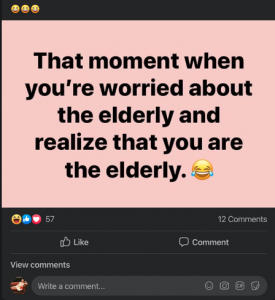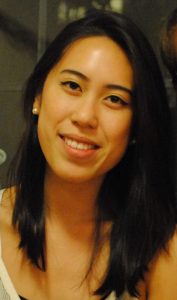While much uncertainty surrounds the coronavirus pandemic, one narrative remains steadfast: people over 60, and especially over 80, are particularly vulnerable to severe or fatal infection. Of the confirmed cases in China, nearly 15% of patients over 80 have died. For those under 50, the death rate was well below 1%. In the U.S., national and local government have encouraged or enforced social distancing measures to protect the elderly. Nursing homes and assisted living centers, for example, have drastically limited or shuttered access for visitors.
The alarming statistics and measures to protect the elderly have given some younger Americans a false sense of security. A parallel narrative has emerged: young, healthy people are invincible. Florida beaches still saw hundreds of thousands of spring breakers who ignored calls for social distancing. Bars and restaurants in DC were packed; young adult patrons reported waiting in “line[s] around the block” for their “last hurrah socially before fully embracing the self-quarantine.”
In addition to physically barricading the elderly, the response to the coronavirus also seems to reinforce the cultural separation of the population into young or old, invincible or vulnerable, us or them. According to National Institute of Allergy and Infectious Diseases Director Anthony Fauci, reducing our understanding of age and Covid-19 to a binary would be a mistake. He stated during CNN’s “State of the Union,” “The virus isn’t a mathematical formula. There are going to be people who are young who are going to wind up getting seriously ill.” And so there are; new data show that up to one-fifth of infected people ages 20–44 have been hospitalized. Age alone does not make one invincible.
Statistics in medicine and public health do a poor job at conveying the spectrum of aging. Humans want to neatly categorize, like over 80 or under 50, but this ignores the fact that we are all aging on a continuum at any given moment. As the literary scholar Sarah Falcus writes, “We may all have a more mobile relationship to age than to other perspectives or subject positions… because we are all aging at any one moment”.[1] Risk data exists for a whole population and cannot simply be applied to any single individual. We are only older or younger in relation to one another.
Part of the difficulty in conceptualizing aging may be due to an elusive definition of old age. Scrolling through my Facebook feed, I noticed an update from my best friend’s dad: “That moment when you’re worried about the elderly and realize that you are the elderly. ?” Mr. S did not feel that he was “old,” but was aged by culture.[1] His musing underscores that aging is hardly a linear, steady process. Per the eighty-two-year-old British novelist Penelope Lively, who writes that her demographic has only the “accretion of years, a historical context, and a generous range of ailments” in common, aging is more than the mere collection of years or passage of time.[1]
So, what makes one feel old? Ceridwen Dovey notes in her New Yorker article that “as people age, they tend to move the goalposts that mark out major life stages.” Her mention of goalposts suggests that human progress and growth are marked by experiences: joy, pain, success, loss, union, and other shared milestones. In this sense then, the pandemic feels immensely disruptive.
When social distancing began in early March, I equated the coronavirus epidemic and the response to it with stagnation. The pandemic caused us to miss major milestones, experience an empty passage of time and unfulfilled aging. Rituals and events—graduations, weddings and anniversaries, professional opportunities, and connections—which mark the passage of time and structure our understanding of time, cease to exist.
Now I understand the pandemic not as stagnation but as cultural restructuring. Despite major disappointments, people are redefining milestones to carry forward. We continue to age. We hold birthday parties, bar mitzvahs, and weddings over video chat. Game nights, happy hours, dance raves, and dates take place virtually. A couple in their 70s recreate an anniversary cruise from home after their trip is cancelled. A Nashville man serenades his mom and her senior citizen friends outside their nursing home. We continue to celebrate the things that make us human: history, literature, art, music. Social distancing is not social isolation.
As the first month of quarantine comes to a close in the U.S., we are also collectively asking, “When can we go back to normal?” Oncologist and bioethicist Ezekiel Emanuel suggests, “We need to stop picturing that ubiquitous “flatten the curve” chart and start imagining a roller coaster.” He predicts that there “may be two to four more rounds of social distancing before this is over.” In other words, this is our new normal. Society will adjust to varying degrees of distancing and intimacy as infection rates wax and wane over several months.
While I agree with Emanuel, his confidence in chaos rattles me. I so desire a neat narrative arc: plot, resolution, a silver lining or two, minimal casualties. In the way that Lively describes the frustrations of autobiographical memory in old age, “The novelist in me—the reader, too—wants shape and structure, development, a theme, insights… Instead of which, there is this assortment of slides, some of them welcome, others not at all, defying chronology, refusing structure,” we, the audience of this pandemic, also want linearity that we simply cannot have.[1] To me, this juxtaposition between desire for certainty and the resulting chaos is aging. This is the pandemic, and this is aging during the pandemic. We can neither “lament nor celebrate it, simply affirm it as a significant part of life.” The pandemic is neither a catastrophe that has suspended time in our society, nor is it a beautiful uniting force. Rather, it has been another chaotic life episode featuring the best of human resilience.
[1] Dovey, Ceridwen. 2015. “What Old Age Is Really Like.” The New Yorker. https://www.newyorker.com/culture/cultural-comment/what-old-age-is-really-like (March 25, 2020).
Tam Nguyen is a MD-MPH candidate at UNC. She is pursuing a career in obstetrics and gynecology. She is particularly interested in psychosocial aspects of women’s health and reproductive bioethics. Tam graduated from Yale in 2014 with a degree in History of Science, Medicine, and Public Health.



